Possible Duplicate:
How can I tell if a point is nearby a certain line?
//Returns the point on the line traced from start to end which
//comes nearest to 500,000, 500,000. The points are scaled between
//1,000,000 and 0 from their original fp types.
Point closestToCentre(Point start, Point end);
Anyone know of quicker way than single stepping through the pixels?
Could some one more alert than me demonstrate their maths & geometry prowess please?
_______EDIT___________
Thanks Kris, this was confusing me :
[x; -a/bx-c/b]=[0; -c/b]-1/b[-b; a]x.
Now I see it is just splitting (mainly the y component) the vector into two which combine to yield the same result. Got the old partial fractions brain cell excited for a minute then :)
_______EDIT_________
Jason Moore, thanks for the inspiration, here is what I am doing, graphically,

I hope that is clearer.
____EDIT________
So I could reasonably expect to take a line at right angles to my sampled line and run it from the centre but how to tell when they touch?

I think Kris's page of equations is the way to go. If you're all telling me it is a two step process. It is just two simultaneous equations now, so I may not need Kris's derivations.
____EDIT_________
Whether good or bad thing, I don't know, but the beauty of stackoverflow as a search engine has revealed to me several routes of investigation. Chiefly I like the first solution here: Shortest distance between a point and a line segment.
But to prove this to my self I needed the link from matti's solution at the bottom (but one):
http://www.topcoder.com/tc?d1=tutorials&d2=geometry1&module=Static
The derivation is so simple and elegant even I could follow it!
Given http://mathworld.wolfram.com/Point-LineDistance2-Dimensional.html